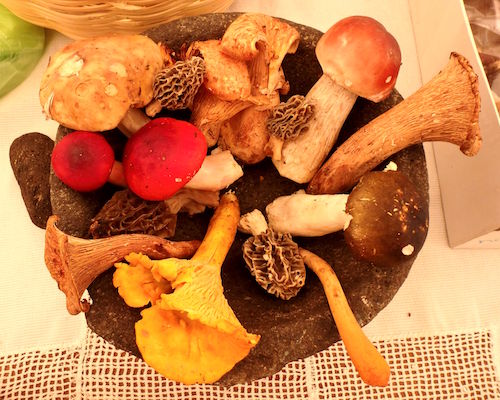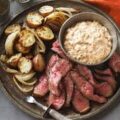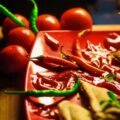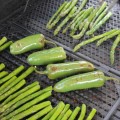By José C. Marmolejo
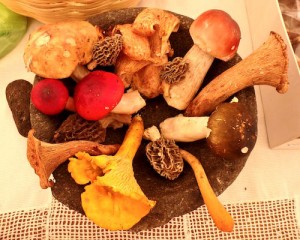 Mid-May marks the beginning of the rainy season in Mexico. It lasts 6 months in Central Mexico and that is the time when forest fires give way to green lush foliage, cooler temperatures and lots of wild mushrooms. It takes about a month or so for the soil to be saturated with rainwater and by the end of June or beginning of July it is possible to go out and harvest some wild mushrooms. One must go accompanied by someone who can distinguish among the edible, the toxic and the “locos” –the ones that make you laugh and see imaginary objects in fancy colors and high definition. But more important is to know whether the edibles are green, ripe or “pasados” –overripe–and this is when a guide’s help comes in really handy. And from the sustainable point of view, one must not harvest them all. Some healthy ones should be left alone for reproduction purposes. Well, I have systematically refused to learn the intricacies of all that. I instead hire a guide and I let her do the work while I enjoy the walk, nature, and the clean air so absent in the big city.
Mid-May marks the beginning of the rainy season in Mexico. It lasts 6 months in Central Mexico and that is the time when forest fires give way to green lush foliage, cooler temperatures and lots of wild mushrooms. It takes about a month or so for the soil to be saturated with rainwater and by the end of June or beginning of July it is possible to go out and harvest some wild mushrooms. One must go accompanied by someone who can distinguish among the edible, the toxic and the “locos” –the ones that make you laugh and see imaginary objects in fancy colors and high definition. But more important is to know whether the edibles are green, ripe or “pasados” –overripe–and this is when a guide’s help comes in really handy. And from the sustainable point of view, one must not harvest them all. Some healthy ones should be left alone for reproduction purposes. Well, I have systematically refused to learn the intricacies of all that. I instead hire a guide and I let her do the work while I enjoy the walk, nature, and the clean air so absent in the big city.
When it is not possible to escape from the asphalt, wild mushrooms can be bought in neighborhood traditional markets around Mexico City during the rainy season and with some luck dehydrated some time afterwards. There are about 50 different species of them, but not all of them appear at the same time. As the season grows old, the rare, the precious, the valuable begin to appear. While all have a distinctive flavor, some are much sought after than others. Morels are a good example of that since the French have made them famous and therefore desirable. Yes, you can find morels in Central Mexico in the wild.
For the people in need, a mixture of fresh edible mushrooms will suffice to make “Sopa de Hongos,” a chicken stock-based soup sprinkled with the sautéed harvest of the day. Also popular and inexpensive are the “Quesadillas de Hongos.” Sorry, contrary to common sense and common belief, there’s no cheese in these quesadillas in Central Mexico, unless you request it to be added–and you will be charged extra for it. Am I saying that a quesadilla may exist without cheese? Most definitely in Central Mexico. In fact, there is an endless discussion –ancient rivalry perhaps–about it between people from the north of Mexico and “Chilangos”–residents of Mexico City—never seems to end. Well, it stopped recently. Here’s how it happened: during the works of search and rescue of the last September’s earthquake in Mexico City, people were asked to scratch with indelible ink the bar codes of the labels on their food donations to prevent the sale of such donations. Also, people were asked to write encouragement messages in the packages for obvious reasons. Well, some food coming from Monterrey was labeled “because of your bravery and service to victims of the earthquake, we let you get away with having quesadillas without cheese.” Aid, encouragement, and humor all at the same time. Where else but Mexico?
But back to our delicious wild mushrooms, once they are harvested and rinsed, they can be blanched and/or sautéed in butter and garlic for the perfect filling of a quesadilla, taco or omelette. One must use only one type of mushroom to appreciate its delicate and distinct flavor. A mixture of several mushrooms will taste good also, but if you train your palate first eating one species at a time, perhaps later you can create a combination where the result is greater than the sum of its parts. This is an endless task and that’s what good chefs do best. So, get out there, find your mushrooms, use the recipes below, and Buen Provecho!!!
Note: these recipes work with all species of commercially grown mushrooms too. Hard texture mushrooms should be cooked a bit longer.
Sopa de Hongos Silvestres (Wild Mushroom Soup)
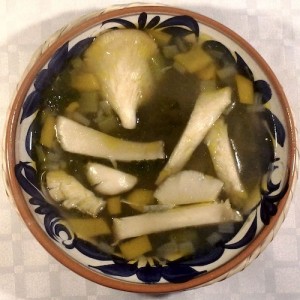
Ingredients
1 lb. of fresh wild mushrooms
1/2 onion, Julienned
1 clove garlic, finely chopped
1 chile chipotle or deArbol
1 tablespoon of cooking oil
1 quart of chicken stock, fat removed
1 sprig of cilantro
Instructions
Wash the mushrooms thoroughly and slice them thinly.
In a pot sautée the onion, garlic, and the chile in the oil. Add the sliced mushrooms and cook lightly for about 2 minutes. Add the stock and cilantro and boil for 5 to 10 minutes.
Yield: 4 servings
Heat Scale: Medium
Ceviche de Hongos Silvestres (Wild Mushroom Salad)
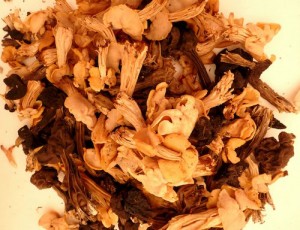
Mix of Fresh Hongos
This ceviche has no seafood and is really a cold mushroom salad.
Ingredients
1 pound wild mushrooms
Juice of 6 lemons
2 tomatoes
1 avocado
1 cucumber
½ onion
1 chile serrano
4 sprigs of cilantro
Catsup to taste
Tomato or Clamato Juice to taste
Salt to taste
Instructions
Wash the mushrooms, cut them in small cubes and place them in a marinating dish with the lemon juice and salt to taste. Marinate for 20 minutes.
Place the following in a bowl:
Cut the cucumber in small cubes. Discard the seeds. Finely chop the onion, the chile and the cilantro. Cut the avocado and tomato in small cubes.
After marinating the mushrooms, drain them and add them to the bowl. Mix everything and place the bowl in the refrigerator for 10 minutes.
Yield: 4 servings
Heat Scale: Mild
Pâté de Hongos Silvestres
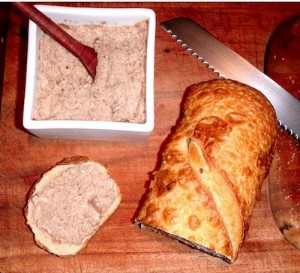
This mixture can be served on crackers or toasted French bread.
Ingredients
1 pound wild mushrooms
1/2 onion, chopped
4 to 6 cloves garlic, minced
1ounce ground almonds or pecans
1 Sprig cilantro or parsley
1 pinch Herbs de Provence
A splash or two of Port wine, Brandy or Cognac (optional)
Salt to taste
Instructions
Wash the mushrooms thoroughly and mix them along with the onion, then sautée them for two to three minutes in olive oil. Add the garlic and sautée for one more minute. Let the mushrooms and onions’ sweat. Add the Porto wine (if applicable) and the herbs and reduce. On a hot pan, toast the almonds or pecans and place them on a grinder with salt to taste. Add to the sautéed mix and grind it until you reach the texture of pâté.
Yield: About 2 cups
Latest posts by José C. Marmolejo (see all)
- Unconventional Seafood Salsas - 04/25/2022
- Cocineras Tradicionales: The Traditional Cooks of Mexico - 04/01/2022
- Carnitas Calientes - 03/11/2022

